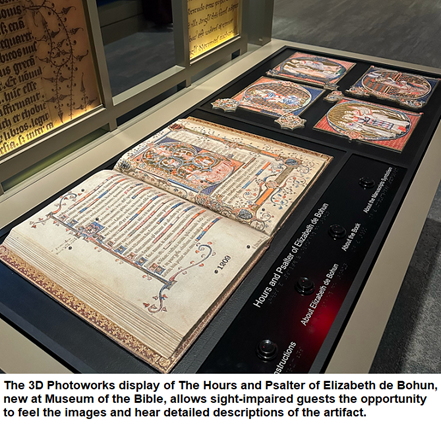‘The Hours and Psalter of Elizabeth de Bohun’ sponsored in part by FedEx and National Federation of the Blind
WASHINGTON, July 27, 2023 — Museum of the Bible continues to update its permanent exhibits with more accessible features enabling guests of all abilities to enjoy its collections. The latest artifact to undergo this upgrade is “The Hours and Psalter of Elizabeth de Bohun,” (ca. 1330-1340).
The 3D Photoworks display of The Hours and Psalter of Elizabeth de Bohun, new at Museum of the Bible, allows sight-impaired guests the opportunity to feel the images and hear detailed descriptions of the artifact.
“Through immersive, technological, and sensory-rich experiences that appeal to sight, sound, touch and smell, the museum provides multiple access points for people of all backgrounds, abilities and perspectives to explore the history, stories, and impact of the Bible,” said Museum of the Bible’s Chief Curatorial Officer Jeff Kloha. “We are excited about the technologies available to us today so visitors can continue to experience important artifacts from our collection in a tactile, multi-sensory way.”
The museum’s History of the Bible permanent exhibition features a gallery of beautifully illustrated illuminated manuscripts, including the spectacular The Hours and Psalter of Elizabeth de Bohun, which gleams with gold leaf and vibrant colors depicting fascinating scenes. Now, with the use of 3D PhotoWorks technology, a tactile installation of this manuscript is available so guests can feel the raised images and letters on the pages as they hear the descriptions, available in both English and Spanish.
The museum’s Senior Curator Brian Hyland expresses appreciation to the National Federation of the Blind and FedEx for the grant program making these interactive exhibits possible. “Many museum artifacts, especially those susceptible to wear and tear, are only allowed to be seen, but not touched, making museums less enjoyable for those who are sight-impaired,” he said. “Now, our guests can not only feel the beautiful artwork in these illuminated manuscripts, but can hear descriptions read to them regarding the colors used, the images depicted and their meaning to the manuscript’s original owners.”
In this case, the featured item is a 14th century Book of Hours and Psalter created for Elizabeth de Bohun, the Countess of Northampton. The manuscript’s exquisite artistry, including historiated and decorated initials, ornate borders and marginal decorations, represents the great wealth and social status of a prominent noble family closely tied to the British monarchy.
Guests can use their fingertips to explore the images on the 3D reproduction of pages from the manuscript. Touch-activated sensors embedded in the reproduction will play recorded descriptions of the images, such as detailing how the initial letter is enlarged and decorated, the depictions of kings and prophets, from the colors of the clothing and accessories to the meanings behind many of the symbols. Recordings explain the identity of each person featured as visitors feel the heraldic shields in the corners of the frame and learn which family is which and why they are important.
“Members of the blind community have explained to me an added value of the tactile experience,” said 3D PhotoWorks founder John Olson. “When they engage with one of our tactile pieces, it allows them to control the experience. During that period of engagement, they are in control and don't need to rely on a sighted person for their thoughts and opinions. For a community that regularly acquires visual information by asking the sighted for assistance, being in control is a great gift that Museum of the Bible has made possible.”
One of the museum’s previous efforts toward inclusivity is the temporary exhibit “Mystery and Faith: The Shroud of Turin.” The interactive experience, entitled “Hear the Shroud,” allows visitors to both feel the raised image of the Shroud and hear about the various markings and what each represents as they pass their hands over the embedded sensors.
“We have already taken several groups of people through the space and have watched them eagerly engage with this experience,” said the museum’s Director of Exhibits Rena Opert. “What is most exciting is this is an interactive experience that attracts, engages and includes everybody who enters the gallery. It embodies the idea of inclusiveness from its conception, rather than having certain elements adapted for accessibility as an afterthought.”
To learn more about these and other interactive exhibits at Museum of the Bible, visit https://www.museumofthebible.org/permanent-exhibits.
About Museum of the Bible
Museum of the Bible is a global, innovative, educational institution whose purpose is to invite all people to engage with the transformative power of the Bible. Making its grand opening to the public in November 2017, Museum of the Bible’s 430,000-square-foot building is located just three blocks from the US Capitol in Washington, DC. Museum of the Bible aims to be among the most technologically advanced and engaging museums in the world. Showcasing rare and fascinating artifacts spanning 4,000 years of history, the museum offers visitors an immersive and personalized experience with the Bible and its ongoing impact on the world around us. For more information, visit museumoftheBible.org.
Acknowledgments:
This display was supported, in part, by a generous grant from the National Federation of the Blind and FedEx. The interactive was designed and fabricated by 3D Photoworks in partnership with Museum of the Bible.
-30-
Media Contact:
Melany Ethridge
melany@alarryross.com
972-267-1111

